Unit 17
The Burial Of Jesus
Chapter 02
Jesus Is Laid To Rest
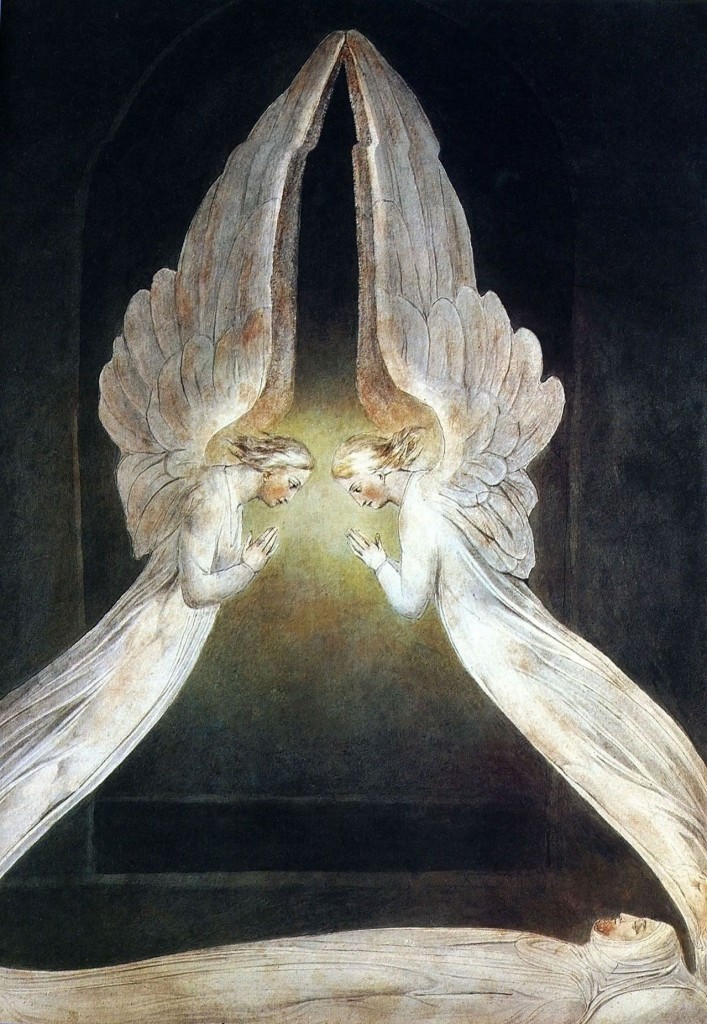
17.02.00.A. CHRIST IN THE SEPULCHRE GUARDED BY ANGELS by William Blake 1805.
Unit 17
The Burial Of Jesus
Chapter 02
Jesus Is Laid To Rest

17.02.00.A. CHRIST IN THE SEPULCHRE GUARDED BY ANGELS by William Blake 1805.
17.02.01 Mk. 15:42-43a Lk. 23:51a; Mk. 15:43b-45 (See also Mt. 27:57-58; Jn. 19:38a) Garden near Golgotha
JOSEPH ASKS FOR BODY
Mk. 42 When it was already evening, because it was preparation day (that is, the day before the Sabbath), 43a Joseph of Arimathea, a prominent member of the Sanhedrin who was himself looking forward to the kingdom of God,
Lk. 51 who had not agreed with their plan and action,
Mk. 43b came and boldly went in to Pilate and asked for Jesus’ body. 44 Pilate was surprised that He was already dead. Summoning the centurion, he asked him whether He had already died. 45 When he found out from the centurion, he gave the corpse to Joseph.
“When it was already evening.” The Jewish people reckoned “evening” in two ways, the earlier and the later.[1]
The reference to “evening” in this crucifixion narrative is to the earlier evening that spans from 3:00 pm to 6:00 pm.
Proper burial was a sacred honor.[2] Even common peasant Jewish people honored strangers with a proper burial. In this case, Jesus, who was a healer and miracle worker, received the most honorable burial. Consequently, Joseph requested the body of Jesus because,
It is for the second reason that scholars believe that the other two crucified men were also removed from their crosses and buried. Pilate, who was anxious not to have a riot on his hands surrendered to the demands of the Jewish leadership. Yet as far as the Romans were concerned, they could not have cared less if a Jew rotted on a cross.
A crucified person suffered not only the pain of dying, but also the pain of insects, birds, and dogs eating his flesh while he was still living. The smell of sweat, blood, urine, and feces, along with the dying groans of those crucified, attracted a number of parasites and predators. To add insult to unspeakable injury, those who begged for a proper burial afterwards were at times told that they would “feed the crows.” An example was written in 20 B.C, by the Roman historian Quintus Horatius Flaccus (65-8 B.C.), otherwise known as Horace who said,
If a slave should say to me, “I have not committed a robbery, nor run away:” “You have your reward; you are not galled with the lash,” I reply. “I have not killed any man:” “You shall not [therefore] feed the carrion crows on the cross.”
Horace, First Epistle 16:46-48[3]
Another example of disregard of the deceased occurred about four decades before Jesus was born. There was a power play in Rome and, Octavius (later known as Emperor Augustus) had defeated Julius Caesar’s murderers at Philippi in October of 42 B.C. The wrath of Octavius was preserved later by the historian Suetonius, who wrote,
He did not use his victory with moderation, but after sending Brutus’ head to Rome, to be cast at the feet of Caesar’s statue, he vented his spleen upon the most distinguished of his captives, not even sparing them insulting the Law. For instance, to one man who begged humbly for burial, he is said to have replied: “The [carrion] birds[4] will soon settle that question.”
Suetonius, The Deified Augustus 13:1-2
In the second century (B.C.) a certain man named Amyzon in Caria had a slave who killed him. The people of the community crucified the slave and left the following inscription:
But the one who did such things to me my fellow citizens hung alive for the wild beasts and birds.
Caria Inscription[5]
Truly, his death was the most agonizing of crucifixions. As previously stated, to have a proper burial was a highly esteemed virtue; failure to have one was worse than the ultimate insult – it was the ultimate annihilation in both the Roman and Jewish world. The difference is that in the Jewish world, death upon a tree or cross was also believed to carry with it a divine condemnation. Therefore, it is not surprising that when the Romans were destroying Jerusalem and the temple, two former high priests of the Caiaphas dynasty, Ananus II and Jesus, in 62 and 64 respectively, were hated so much that they were killed and their bodies were not buried. It was as if the rioting executioners initiated a divine curse on them. Josephus reported this account:
They actually went so far in their impiety as to cast out the corpses without burial, although the Jews are so careful about funeral rites that even malefactors who have been sentenced to crucifixion are taken down and buried before sunset.
Josephus, Wars 4.5.2 (317)
By the time the First Revolt erupted, the common Jewish people had as much hatred for the temple establishment as they did for the Romans. They were not about to give the Sadducean priesthood any dignity, rather, they were determined to give them the ultimate insult and ultimate annihilation – death without a burial.
Finally, if Joseph of Arimathea and Nicodemus, both distinguished members of the Sanhedrin, truly believed that Jesus was a criminal, they would never have violated Deuteronomy 21:22-23, that states a criminal who blasphemes against God should be stoned to death. Rather these righteous Pharisees recognized Jesus as One sent by God, although at this point they may not have recognized Him as the Messiah. To honor Jesus, Joseph of Arimathea donated his tomb that was not in a cemetery, but in a private garden outside the city.[6] In their deepest sorrow they mourned their huge loss, but absolutely no one was expecting the resurrection that was about to come.
17.02.01.Q1 Does Luke 23:1 conflict with 23:51?
The first verse of Chapter 23 indicates that the entire court voted against Jesus whereas verse 51 states that Joseph of Arimathea[7] did not consent to their decision. This is not a matter of conflict, but indicates that he was not present during the trial. The Sanhedrin was composed of seventy members, plus the high priest who was also the president. For a capital crime, only twenty-three members plus the president had to serve as judges. In this case the court judges were hand selected by Caiaphas to agree with his decision. Joseph of Arimathea was among those absent.
[1]. Vincent, Word Studies in the New Testament. 1:146.
[2]. In a similar manner, centuries later the Muslims build the Dome of the Rock over the temple site and converted St. Mary’s Church, located on the Temple Mount, into a mosque. They never touched Gordon’s Garden Tomb.
[3]. http://www.authorama.com/works-of-horace-8.html. Retrieved October 8, 2012; Crossan, Who Killed Jesus? 161.
[4]. The term “carrion birds” or “birds” is a reference to crows.
[5]. Quotation cited by Cook, “Crucifixion and Burial.” 204; Liewelyn, New Documents Illustrating Early Christianity: A Review of the Greek Inscriptions and Papyri Published 1984-1985. 8:1-3.
[6]. Many Jerusalemites had gardens on the northern side of the city and these gardens were enclosed in the early 40s by King Agrippa when he constructed a new city wall.
[7]. Arimathea was a small village about twenty miles west of Jerusalem in the hill country of Ephraim.
17.02.02 Jn. 19:38b-40; Mt. 27:59-60a; Jn. 19:42; Mt. 27:60b Lk. 23:55-56 Calvary
JESUS IS BURIED
Jn. 38b Pilate gave him permission, so he came and took His body away. 39 Nicodemus (who had previously come to Him at night) also came, bringing a mixture of about 75 pounds of myrrh and aloes. 40 Then they took Jesus’ body and wrapped it in linen cloths with the aromatic spices, according to the burial custom of the Jews.
Mt. 59 So Joseph took the body, wrapped it in clean, fine linen, 60a and placed it in his new tomb, which he had cut into the rock.
Jn. 42 They placed Jesus there because of the Jewish preparation and since the tomb was nearby.
Mt. 60b He left after rolling a great stone against the entrance of the tomb.
Lk. 55 The women who had come with Him from Galilee followed along and observed the tomb and how His body was placed. 56 Then they returned and prepared spices and perfumes. And they rested on the Sabbath according to the commandment.
Stoning was both the form of Jewish execution and a method of burying a criminal. But on the other hand, Gentile criminals were often not buried. Their bodies remained on the crosses until natural processes and wild animals devoured all flesh, and only a few bones remained on the ground.
“Nicodemus… (and) Joseph took the body.” This action caused them to become ceremonially impure. Therefore, they could not participate in the Passover celebration (Num. 19:11). The placement of the body in the tomb and the burial process clearly demonstrated that their love for Jesus was greater than their love for the law, their social reputation, or personal safety. They removed the body of Jesus because,
“About 75 pounds.” This huge amount of spices was generally reserved for royalty, as recorded when King Asa died. His body was also “covered with spices and various blends of perfumes” (2 Ch. 16:14).[1] The treatment of the body of Jesus was the cultural norm for anyone of wealth, but quite unusual in light of His peasant lifestyle. In this case, both men and women, who dearly loved Him, placed spices upon His body.
The care given to the body is another sign that He had died. Any sign of life would have immediately brought forth those who would have nursed Him back to health. However, this was not the case. The fact that the body of Jesus was placed in a new tomb of Joseph of Aramathea, fulfills a prophecy of Isaiah who said,
9 They made His grave with the wicked,
and with a rich man at His death,
Although He had done no violence,
and had not spoken deceitfully.
10 Yet the Lord was pleased to crush Him severely.
when You make Him a restitution offering,
He will see His seed, He will prolong His days,
and by His hand, the LORD’s pleasure will be accomplished.
Isaiah 53:9-10
17.02.02.Q1 How was the burial of Jesus similar to the Exodus?
The burial of Jesus was similar to the hasty exodus by the children of Israel as they left Egypt, when they barely had time to gather their belongings and leave. Jesus was crucified at 9:00 a.m. and was dead by 3:00 p.m. in the afternoon. There was very little time left before the Sabbath would begin about three hours later. So the body had to be taken down in haste, properly prepared for burial, and buried before three stars appeared in the sky (the sign of the end of the day and the beginning of the day of Passover). Jews did not practice any type of embalming, but washed the body and wrapped it in spices and linens.[2] The burial process included pronouncing a blessing over the spices.[3] The burial rituals for Jesus were hastily performed as the sun was setting. Just as the Israelites had walked through the Red Sea into a new life and new freedom, Jesus walked through the gates of hell and arose to give humanity a new life and new freedom.
There are two significant issues here:
At this time, a tomb was a cave-like chamber carved out of the rock with a shelf or bench to one side, where the body would be placed. After the flesh was completely decayed, the bones would be collected and placed in a clay, wooden, or stone box known as an ossuary. Wealthy families acquired stone ossuaries, while common peasants acquired ones made from wood or clay. The name of the deceased was placed on the box and, at times, his occupation was mentioned as well.[5] Tombs were used repeatedly by the same family. It was said that the deceased was “gathered to his kin” (Gen 25:8) or was “sleeping with his fathers” (1 Kg. 11:23).
17.02.02.Q2 Why was Jesus buried in a new tomb?
Jesus was buried in a new tomb, because failure to do so would have broken the law of unrelated identities. This law originated with Moses and was, therefore, deemed highly important. The Jews believed, for example, that mules and donkeys could not be yoked together for any type of agricultural activity, nor could Jews marry non-Jews. Likewise, New Testament teaches that believers and unbelievers were not to be married. Rules of such unrelated identities were extended to include burial tombs and stated that only family members could be buried in family tombs.
Since Jesus was the Son of God and not the son of two earthly parents, He was buried in a new tomb that never had been used by anyone’s family. Even after His death, Jesus honored the Mosaic Law of unrelated identities. To have buried Him in a family tomb would have identified Him with that particular family. Jesus was both Son of Man and Son of God and, hence, He was in need of a new tomb.
The Babylonian Talmud, on the other hand, indicates that executed criminals were not buried in the family tomb, but in one of two cemeteries as determined by the mode of death. The Talmud reads:
And they did not bury him (the executed person) in his ancestral tomb, but two burial places were prepared by the beth din, one for those who were decapitated or strangled, and the other for those who were stoned or burned.
Babylonian Talmud, Sanhedrin 46 a-b
Although this regulation was not always observed, it was a way to disconnect the shame of the criminal from his family. Nonetheless, innocent victims who were crucified were buried in family tombs. The possible separation of burial apart from former family members served to discourage those who entertained thoughts of committing a crime.
17.02.02.Q3 Where was Jesus buried?
For centuries the burial tomb of Jesus was accepted as being in the Church of the Holy Sepulchre. However, for more than a century, Protestants have followed the opinion of a General Gordon who said Jesus was buried in the Garden Tomb. A third site has emerged and, all three are listed below, followed by a brief discussion of each.
In the spring of 1988, a book titled Secrets of Golgotha[6] challenged the prevailing opinions of scholars with the argument that Jesus was crucified on the Mount of Olives. While the fact that Jesus died when the Passover lamb was sacrificed is undeniable, the author also connects the burning of the red heifer[7] symbolically to Jesus.[8]
The Jewish records state that the altar for the red heifer sacrifice was located east of the temple.[9] To accommodate the priests, Herod the Great had built a double-tiered arched bridge that connected the Eastern Gate to the Mount of Olives. That bridge was known as the Bridge of the Red Heifer and, in fact, appears to have been constructed solely for that purpose and to lead the scapegoat out of the temple and into the desert.[10] The bridge did not connect to any highways and there were no major communities east of the Mount of Olives; only a village known for its lepers, a huge olive grove, and an altar that has been lost in history. It would have been most unusual to build a huge bridge for merely a small village and olive grove. Therefore, its purpose had to be connected to sacrificial observances. While the sacrifice of the Passover lamb is well established in Christendom, the meaning of the sacrifice of the red heifer and how it relates specifically to Jesus is seldom discussed. In fact, it appears to have been forgotten in history. The author of Secrets essentially states that Jesus was crucified on the Mount of Olives as a sin offering just as the red heifer was previously burned as a sin offering. An interesting statement in the Mishnah says that the eastern wall of the temple was lower than the other walls so the high priest, when burning the red heifer, could look directly into the temple.
All the walls there were high, save only the eastern wall, because the [high] priest that burns the [red] heifer and stands on the top of the Mount of Olives should be able to look directly into the entrance of the Sanctuary when the blood is sprinkled.
Mishnah, Middoth 2.4[11]
An essential question he proposes is this: Why have so few theologians, archaeologists, and historians been interested in finding the site of the red heifer altar on the Mount of Olives?[12] Maybe in the future this question will be answered, but until then, Martin’s thesis is set aside and additional attention is given the two other sites.[13]
Concerning the two most popular sites, there are two views as to determine which site is authentic. Many Protestants believe it is the Garden Tomb, while Roman Catholics, Armenians, and Greek Orthodox Christians believe it is the tomb within the Church of the Holy Sepulchre. These differences may be anchored more by theological biases than by scientific research, especially since the 1990s have revealed the identity with overwhelming evidence. There are those, however, who continue to insist that the Garden Tomb is authentic, in spite of its shaky history.
When evangelical Christians think of the burial place of their Lord, they generally think affectionately of the Garden Tomb. It is certainly a beautiful garden with its winding walkways, shrubbery, and trees — a peaceful and quiet setting in a modern city that never sleeps except on high holy days. But is it really the place where Jesus was buried?
17.02.02.Q4 What are the arguments for Gordon’s Garden Tomb?
The Garden Tomb as being the tomb of Christ was the site suggested by Otto Thenius in 1842. It was investigated again in 1883 by British General Charles George Gordon, and his name has been associated with the tomb ever since. The decisions by Thenius and Gordon were based upon three observations, but apparently without any review of the first century history of Jerusalem.
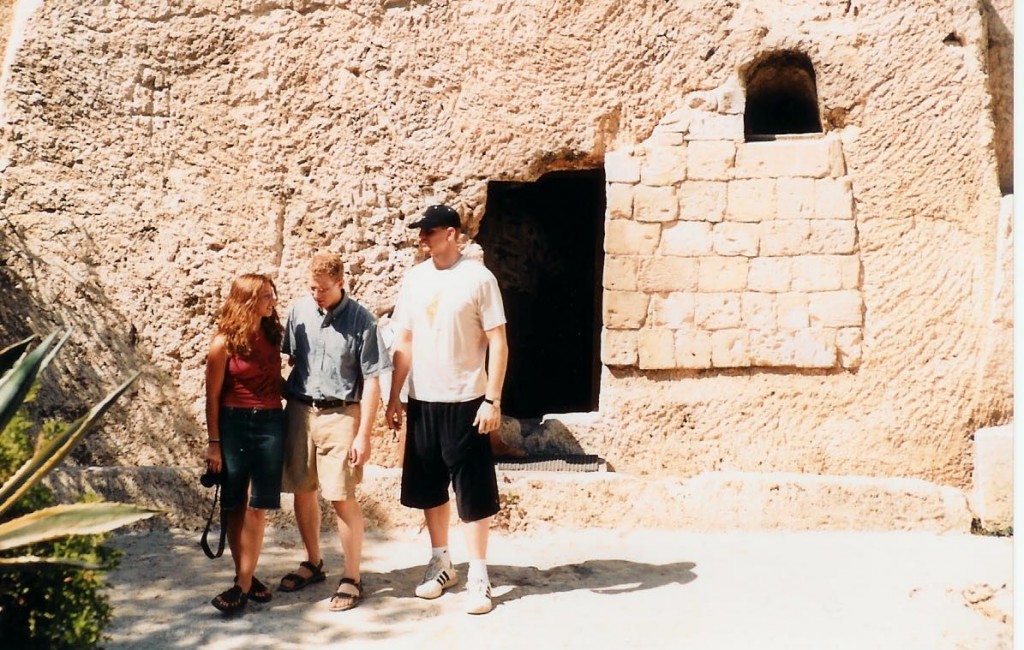
17.02.02.A. THE TOMB AT GORDON’S CALVARY. Also known as the Garden Tomb, Gordon’s Calvary has unquestionably been identified as a late Iron Age (8-7th Cent. B.C.) tomb, and hence, not the tomb of Jesus. However, while it is not the authentic tomb, it has become the symbol of the resurrected Christ. Photograph by the author.
In 1885 the Gordon popularized the site in an article published in the Palestine Exploration Fund’s Quarterly Statement.[16] His theory was quickly accepted as fact by Protestants, who at that time were forbidden entry into the Church of the Holy Sepulchre. To aid their argument, an inscription on a stone found nearby was incorrectly translated and published on November 7, 1889 in the Northern Christian Advocate (Syracuse, New York).[17] The science of archaeology was still in its infancy and whatever “archaeological proof” that would have been uncovered at that time would have been challenged and probably revised within a century. This was one of many articles that attempted to prove the identification of the tomb of Christ, although there was no archaeological evidence to support the theory. Furthermore, this tomb is significantly different from first century tombs.[18] As a result, many Christians visiting the Holy Land today are incorrectly convinced of the authenticity of the site.
In the first century, residents of Jerusalem had their gardens and orchards around the entire city, and the level area on the north side of the city was especially ideal for gardening. In order to protect this valuable area, in the years A.D. 41 to 44 Herod Agrippa, the grandson of Herod the Great, built the Third Wall that enclosed the gardens as well as the tomb of Christ (see 17.02.02.Z1).[19] However, since the Holy City was the scene of many wars and suffered many destructions, this wall was eventually destroyed and its exact location is unknown today. The northern city wall seen today was constructed by Suleiman the Magnificent in the 1536-1538 (see 17.02.02.Z2).[20] This lead to an incorrect identification of the Garden Tomb in the 1800s by General Gordon because he believed that the Old City wall standing today was the same as at the time of Christ.
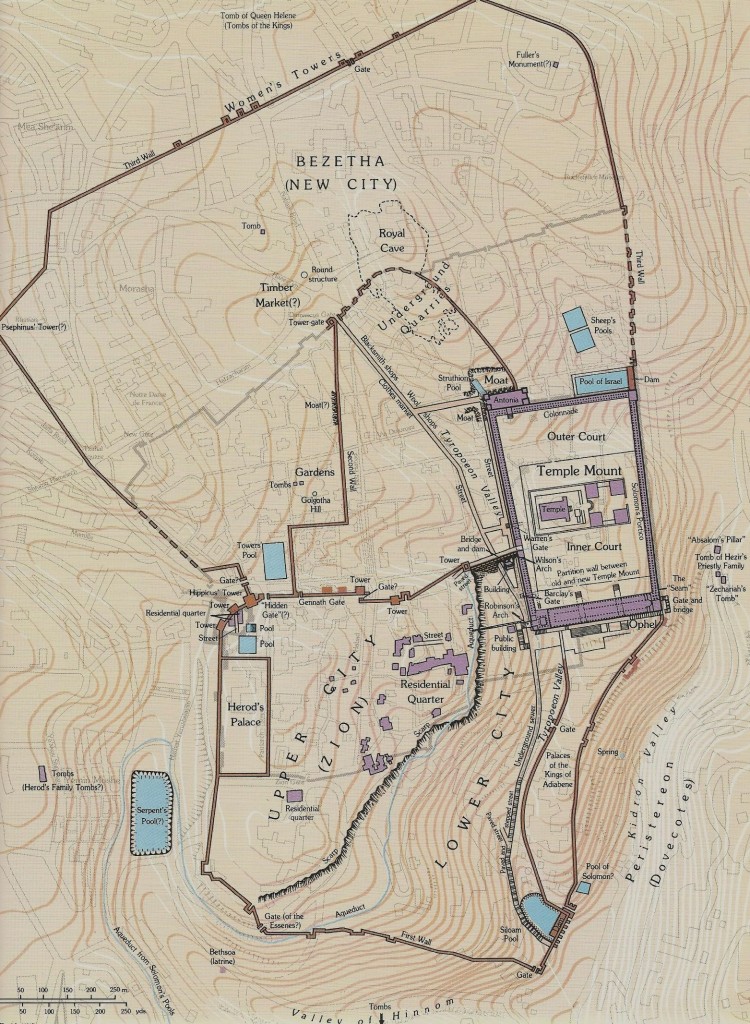
17.02.02.Z1. MAP OF JERUSALEM WITH VEGETABLE GARDENS AND HEROD AGRIPPA’S THIRD WALL. In the years A.D. 41 to 44 Herod Agrippa, the grandson of Herod the Great, built the Third Wall with Women’s Towers that enclosed the gardens on the north side of Jerusalem as well as the tomb of Christ. This wall was later destroyed and its precise location is unknown today. Map courtesy of Dan Bahat.[21]
17.02.02.Q5 What are the arguments against Gordon’s Garden Tomb?
What Gordon did not realize was that within fifteen years after Jesus, Herod Agrippa (reigned 41-44), constructed a new city wall that Josephus referred to as “The Third Wall.”[22] In the centuries that followed there were many conflicts and destructions of the Holy City. As a result, the Third Wall was destroyed and its precise location is still unknown today. However, in the years 1538 to 1541, the great Muslim ruler Suleiman the Magnificent employed two architects to determine where the ancient wall once stood. Based upon their findings, the Old City Walls seen today were constructed.[23] However, after the reconstructed wall was finished, Suleiman discovered the architects made an error and had them decapitated.
As to General Gordon, there are five significant points that he never considered.[24]
If General Gordon were alive today, he would be discouraged to learn that archaeologists clearly identified his Garden Tomb to be a Late Iron Age tomb (8th or 7th century B.C.).[28]
Video Insert >
17.02.02.V1 The Garden Tomb. Archaeologist Dr. Bryant Wood discusses the date of the Garden Tomb as an Iron Age II tomb, meaning it was used in the 8th to 7th century B.C.
17.02.02.Q6 What descriptive biblical parameters aided archaeologists in identifying the kind of tomb in which Jesus was laid?
The descriptive parameters are as follows:
17.02.02.Q7 What were the typical first century tombs like?
In the first century, the tombs in the Jerusalem area were of two distinct styles, uniquely different from each other and from prior centuries.
Each shaft or niche, called a kokhim in Hebrew, was approximately six or seven feet long and one and one-half or two feet wide, large enough to lay a body (see photo 17.02.02.B). That matches the rabbinic directives that stated that a niche had to be four cubits long and seven handbreadths high and six handbreadths wide.[32] After a year, when the flesh had decayed, the bones were collected and placed in a small ossuary made of wood or soft limestone. This was the most common and typical first century tomb.
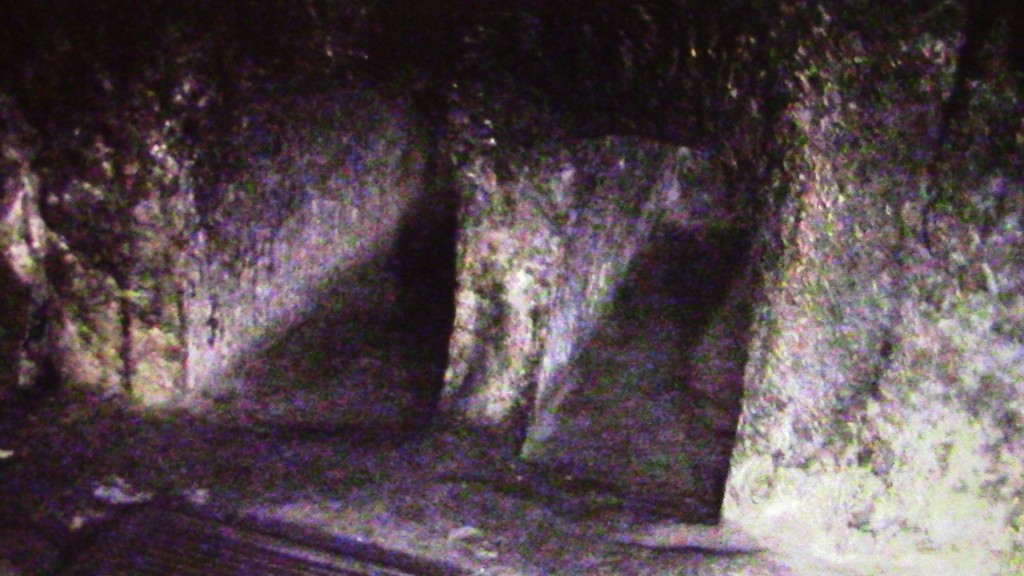
17.02.02.B. TWO SHAFT TOMBS IN THE CHURCH OF THE HOLY SEPULCHRE. In one of the small rooms within the Church of the Holy Sepulchre are these shaft tombs which were used by common Jewish peasants of the first century. The arcosolium tomb of Jesus was destroyed by Emperor Hadrian in A.D. 135. Photograph by the author.
The origin of the shaft tomb is unknown. Some scholars believe it originated in Egypt, others believe it came from Phoenicia and was popularized by Alexander the Great.[33] The wealthy arcosolium tomb is believed to have originated in the late Inter-Testamental Period, replacing bench tombs such as the Garden Tomb of the Iron Age as was typical in the First Temple Era.[34]
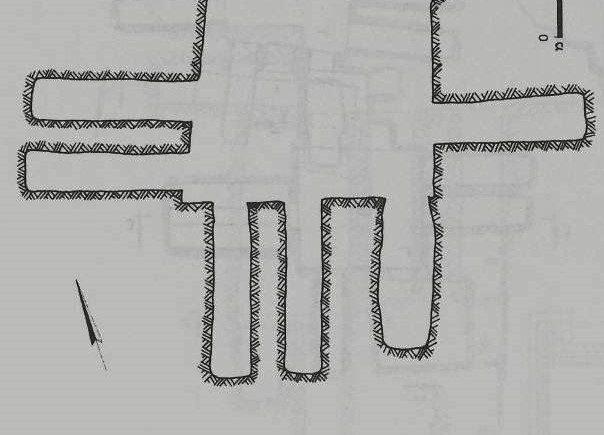
17.02.02.C A FLOOR PLAN ILLUSTRATING A COMMON SHAFT TOMB. This plan depicts six shafts or “niches,” where the bodies of common people were laid to decompose. The entrance on the right opens into the main chamber that is about three meters square. After the bones were collected and placed in ossuaries, the ossuaries were placed anywhere within the tomb. Illustration by Amos Kloner.[36]
Scholars believe it was an arcosolium tomb in which the body of Jesus was laid (see 17.02.02.D below) as this was an expensive style that only the wealthy could afford.[37] The Church of the Holy Sepulchre is shown in 17.02.02.D because the hillside in which the tomb was located was destroyed by Hadrian who quarried the stone and built the shrine over the tomb to honor the Roman goddess Venus.
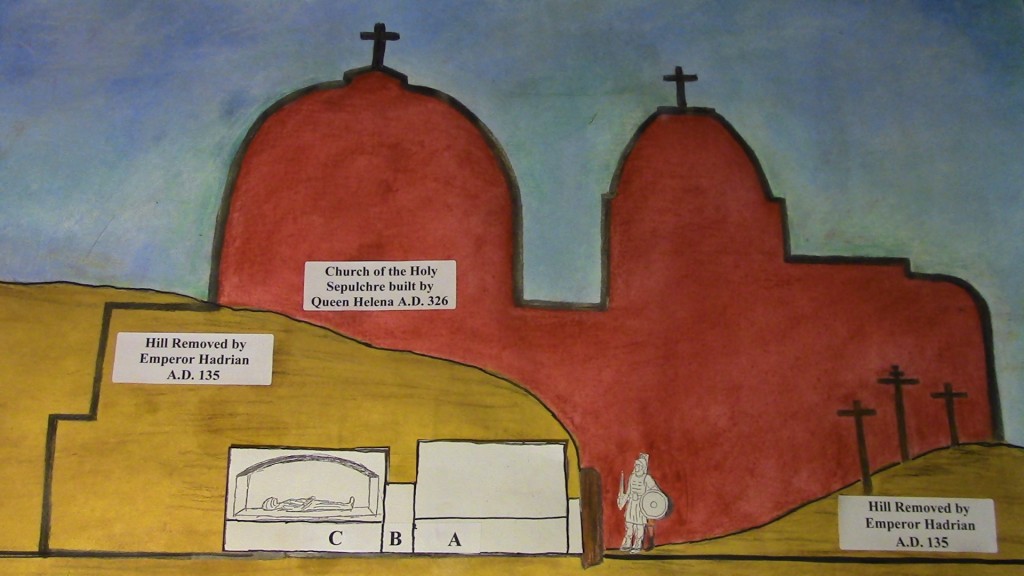
17.02.02.D AN ILLUSTRATION OF A DOUBLE CHAMBER ARCOSOLIUM TOMB WITH SHADOW OF THE CHURCH OF THE HOLY SEPLUCHRE. This illustration depicts a possible reconstruction of the tomb of Aramathea. Mourners visiting this tomb would have sat on a bench in chamber “A,” them moved through a small opening “B” to the second chamber “C” where the body was laid on a bench under an arched ceiling. The hillside was eventually destroyed. Illustration by Diana Clegg.
Determining the identity of Christ’s tomb was a great challenge since the Church of the Holy Sepulchre claimed to be both the authentic crucifixion and burial sites, the two being merely some fifty or sixty feet apart. The following is a brief overview of the historical events that reveal the identity of the authentic tomb of Jesus.
Video Insert >
17.02.02.V2 The Two Types of First Century Tombs. Professor Gordon Franz discusses the differences between the two types of first century tombs. His emphasis is on the distinctive features of the Garden Tomb and those of the Tomb of Joseph of Arimathea.
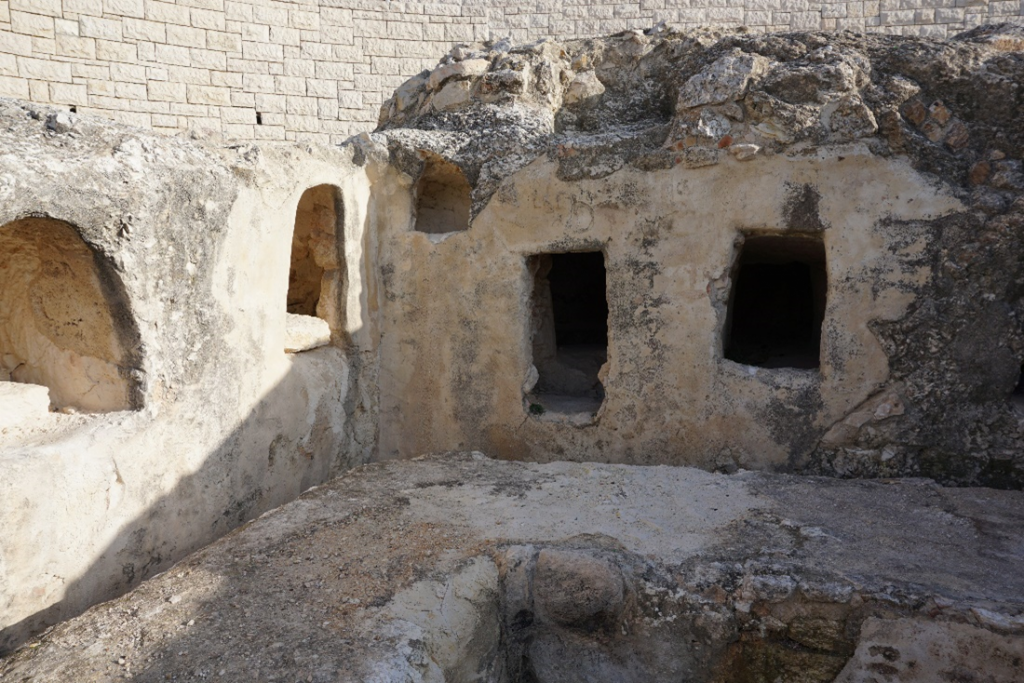
17.02.02.D. AN EXPOSED TOMB. An exposed tomb, the top removed, shows an arcosolium (plural: arcosolia) tomb on the left, three conventional tombs, and a bench in front of them. Bodies of the deceased were laid in these tombs until the flesh was decayed, then the bones were collected about a year later and placed in an ossuary. Photo by Jeff Herot.
After the Romans destroyed the temple and Jerusalem in A.D. 70, the city was rebuilt. But six decades later, the Jews revolted again which resulted in yet another destruction in the year 135. In both wars, the Romans spent three years besieging the Holy City. Since there were thirteen rebellions between 63 B.C., when the Romans came, and A.D.70, by the time they defeated the Jews again in A.D. 135, Emperor Hadrian and the rest of Rome had enough of them and decided to permanently eliminate them. Like Antiochus IV Epiphanes and the Egyptian Pharaoh of previous centuries, he wanted to remove any trace of these aggravating people.
Likewise, Hadrian had no great love for the new religious sect known as “Christians,” since, like the Jews, they also refused to participate in emperor worship.[38] Therefore, if he was going to get rid of the Jews, why not the Christians also? He determined to destroy whatever people, symbols, shrines, and buildings that existed in the Jerusalem area, although he was more sympathetic to those living in the countryside villages.
He found the site where local Christians said Jesus was crucified and buried. To celebrate his victory over them, he built a shrine to the goddess Venus over the site of the tomb. He took Herodian ashlars (large rectangular stones cut by Herod the Great) from the ruined temple and reused them to build rectangular retaining walls for the shrine.[39] Upon these walls, he built a platform for his shrine to (Latin) Venus (also known as Aphrodite to the Greeks), the goddess of love. His goal was to forever obliterate the tomb of Jesus, as well as the nearby rock of Golgotha. He never touched Skull Hill or Gordon’s Garden Tomb and, therefore, it remained undisturbed for centuries, until 1883.[40]
Hadrian was determined to eradicate anything Jewish – and Jesus and His disciples at this time were still considered part of Judaism. However, with the construction of the shrine, he permanently identified the site, because, when Emperor Constantine sent his mother Queen Helena to the Holy Land in 325-326 to locate the sacred sites, she quickly found the remains of the sacred cave and ruins of the shrine. Some fifty feet nearby was another Roman shrine which had been built over the crucifixion site.[41] Helena employed skilled workers to tear down the shrine and construct the Church of the Holy Sepulchre. When Eusebius, the bishop of Caesarea Maritima, heard of her plans, he voiced support for the adornment of the building as follows:
It is my wish, then, that you should be especially convinced of this, which I suppose is clear to everyone, that of all things it is my chief concern how we may splendidly adorn with buildings that sacred place which, under divine direction, I freed…Not only shall this basilica be the finest in the world, but that the details also shall be such that all the most beautiful structures in every city may be surpassed by it….As for the columns and marbles, have a care to tell us in writing, after you have inspected the plan, whatever you judge to be most precious and serviceable so that those materials, of whatever sort and in whatever quantity, may be procured from every quarter.
Eusebius, The Life of Constantine 3.29-32
Because of this unusual history, the Church of the Holy Sepulchre is, without question, one of the most accurately identified biblical sites.[42] It was so significant that it later appeared on the sixth century mosaic Madaba Map on the floor of a Byzantine church in Madaba, Jordan.[43] Extensive research conducted in the 1990s firmly identified the church as to where both the crucifixion and burial sites are located. Ironically, little did Hadrian know that by destroying the holy site, he was in fact, preserving it. Eusebius described the construction work of Hadrian’s slaves and soldiers, they…
… Brought a quantity of earth from a distance with much labor, and covered the entire spot; then, having raised this to a moderate height, they paved it with stone concealing the holy cave (tomb) beneath this massive mound. Then, as though their purpose had been effectually accomplished they prepared on this foundation a truly dreadful Sepulchre of souls, by building a gloomy shrine to the lifeless idols to the impure spirit whom they call Venus.
Eusebius, The Life of Constantine 3:26[44]
From the time of Hadrian until Constantine, nothing changed. Then, in 326, Queen Helena identified the crucifixion and burial sites by finding the ruins of the shrine of Venus.[45] She immediately removed all traces of pagan worship and again Eusebius preserved the account.
He (Constantine) gave orders that the materials of what was destroyed, both stone and timber, should be removed and thrown as far from the spot as possible….he directed that the ground itself should be dug up to a considerable depth, and the soil which had been polluted by the foul impurities of demon worship transported to a far distance place.
Eusebius, The Life of Constantine 3:26
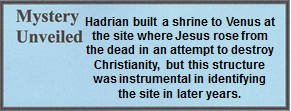
The site identification in the early fourth century was relatively easy. The destruction of Jerusalem and the work of Hadrian were still common knowledge. Queen Helena’s accuracy cannot be disputed and when the clearing work was completed and a new church built, Constantine said this:
…I have disencumbered as it were of the heavy weight of foul idol worship; a spot which has been accounted holy from the beginning in God’s judgment, but which now appears holier still, since it has brought to light a clear assurance of our Savior’s passion.
Eusebius, The Life of Constantine 3:30
Eusebius wrote of Constantine’s desire to build “a house of prayer” upon the site where Jesus was buried:
He judged it incumbent on him to render the blessed locality of our Savior’s resurrection an object of attraction and veneration to all. He issued immediate injunctions, therefore, for the erection in that spot of a house of prayer.
Eusebius, The Life of Constantine 3:25
Were it not for Constantine and his mother Helena, many sacred sites would have been lost in history. The new church was called the Church of the Martyrion, a portion of which remains. The word “Martyrion” (Gk. witness) meant the site was the witness of the death and resurrection of Jesus Christ.[46] Years later the name was changed to the Church of the Holy Sepulchre.
In the second half of the last century, a number of repairs were made to the Church of the Holy Sepulchre which exposed a number of stones that scholars believe were part of the original Constantine structure.[47] Furthermore, in 1975 construction workers found, near St. Helena’s chapel (part of the Holy Sepulchre) a red and black picture of a Roman sailing ship with the Latin phrase Domine iuimus, meaning Lord, we went (cf. Ps. 122:1). Historians believe this graffiti was placed on the wall in 330, only a few years after the completion of the church.[48]
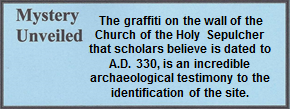
Video Insert >
17.02.02.V3 The Church of the Holy Sepulchre as the Former Shrine of Venus. Dr. Petra Heldt discusses the reconstruction of Jerusalem by Emperor Hadrian in A.D. 135, and how his work is believed to have preserved the identity of the tomb of Jesus. Dr. Paul Wright discusses some stones in the Church of the Holy Sepulchre that may have been used previously in Hadrian’s shine to the Roman goddess Venus. Introduction and comments by Dr. Bill Heinrich.
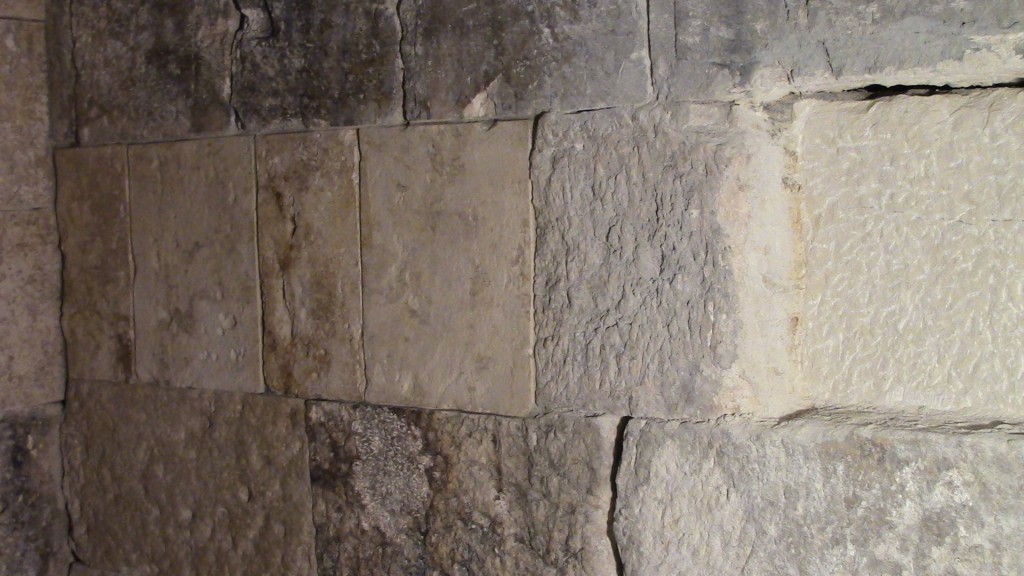
17.02.02.E. HADRIAN’S WALL AT THE HOLY SEPULCHRE. Some rooms of the church have an unusual mix of stones. Some scholars to believe the smooth stones are “second use stones” that were originally part of Hadrian’s shrine of Venus.[49] This opinion is based on the logical idea that when Queen Helena built the Church of the Holy Sepulchre, she used stones from the shrine that were already cut and smooth. Photo by the author.
Many ancient sites have been easy for archaeologists to identify since Queen Helena built churches over them with a foundation of a unique architectural style. Fellowship churches were constructed in the form of a cross, whereas memorial churches were built in the shape of an octagon.[50] The Church of the Holy Sepulchre has been partially destroyed and rebuilt several times, but it has maintained a continuous history. The queen, just like General Gordon centuries later, was faced with “the wall dilemma,” because she, too, had to contemplate the tomb location in light of the city walls. The local residents told her of King Agrippa’s third city wall and, hence, she rendered a better decision. Christianity will always remember her work because it preserved the site of the tomb of Jesus.[51]
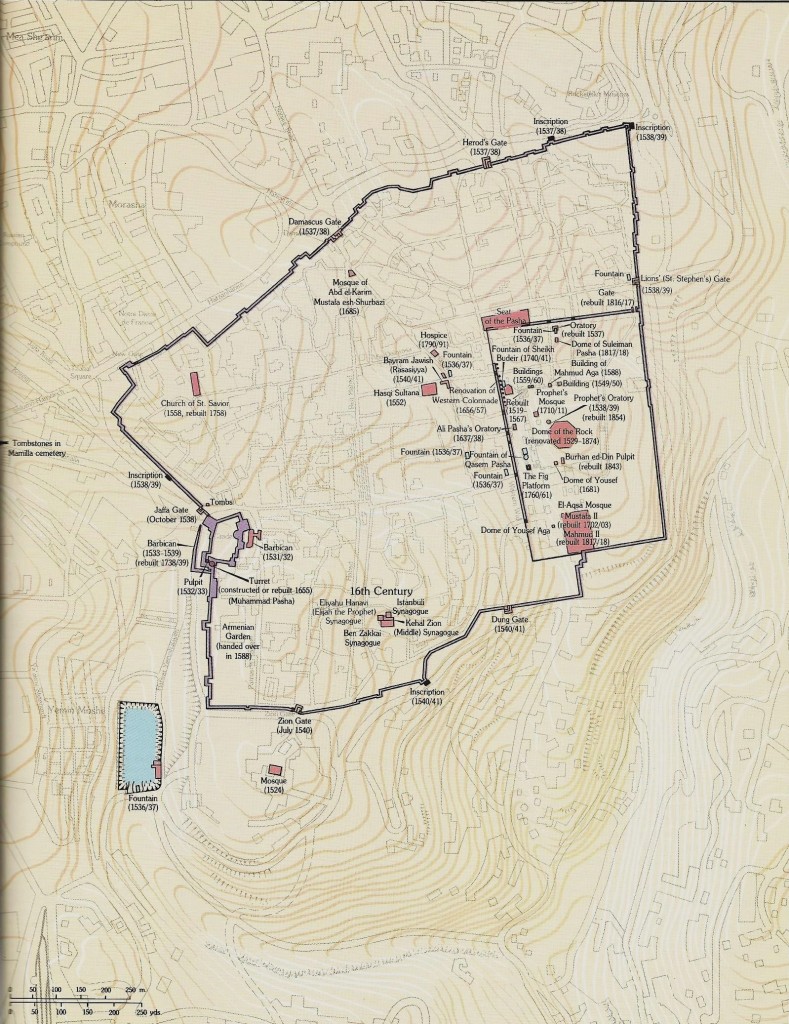
17.02.02.Z2. MAP OF JERUSALEM’S OLD CITY WALLS AS SEEN TODAY. In the years 1536 – 1538 Suleiman the Magnificent of the Ottoman Empire employed two architects to determine where the original city walls were located. The walls were repaired, and some sections rebuilt, according to their recommendations. However, it was later discovered that they made some errors and consequently, were decapitated. In the 1800s General Gordon mistakenly believed that the walls he saw were the walls standing at the time of Jesus, and therefore, he concluded the tomb was outside Suleiman’s walls. Map by Dan Bahat.
17.02.02.Q8 Is the burial cloth of Jesus, known as the Shroud of Turin, authentic (Mt. 27:59)?
There has been a great controversy concerning a burial cloth that was hidden in a small northern town of Turin, Italy for many centuries. Known as the Shroud of Turin, the ancient burial cloth is said to have been the shroud that was wrapped around the body of Jesus as He lay in the tomb.[52]
The Mishnah and Code of Jewish Law,[53] both provide some interesting insight into this question. John 11:44 states that Lazarus came out of the tomb with his face wrapped in a cloth. In other words, his chin was bound up “that it may not sink,” as described in the Mishnah below. Later, John said in 20:7, in reference to where the body of Jesus was laid, that the wrapping that had been on His head was not lying with the linen cloths, but was folded and placed elsewhere. Twice John mentioned the head wrapping, a cultural custom mentioned in the Mishnah, and is also noticeable on the Shroud of Turin.
They may make ready [on the Sabbath] all that is needful for the dead, and anoint it and wash it, provided that they do not remove any member of it. They may draw the mattress away from beneath it and let it lie on sand that it may by the longer preserved; they may bind up the chin, not in order to raise it, but that it may not sink lower. So, too, if a rafter is broken they may support it with a bench or with the side-pieces of a bed that the break may grow no greater, but not in order to prop it up.[54] They may not close a corpse’s eyes on the Sabbath; nor may they do soon a weekday at the moment when the soul is departing; and if he closes the eyes [of a dying man] at the moment when the soul is departing, such a one is a shedder of blood.
Mishnah, Shabbath 23:5[55]
The most unusual feature of the shroud is that it contains an X-ray type image of a man with all of the wounds and bruises that are normally associated with a crucifixion execution,[56] that also match all related biblical passages.[57] The image is on the surface of the fabric and not through the fibers of the fabric. In 1978 a team of 32 scientists examined it for five days with the most sophisticated scientific testing equipment and, as of this writing, there has not been a definitive decision rendered as to its authenticity.[58]
Note the following signs of human injury on the shroud compared to the injuries suffered by Jesus:[59]
In addition, there are five major wounds associated with death by crucifixion.
In light of these details, it is also noteworthy that it was common practice for the Romans to break the legs of crucified criminals to hasten death and, thereby, reduce their suffering. There is no sign of leg fracture in the shroud. While this is an argument from silence, in light of the fact that the shroud shows such vivid details, if the person who was crucified had his legs broken, there surely would be signs revealing these.
While several other so-called antiquities have been identified as fakes that certainly does not prove the shroud is also a forgery. Yet, there is no longer any blood on the shroud.[60] Furthermore, could such a medieval artist have the skills to outwit today’s sophisticated scientists and technology? It appears impossible since today’s scientists cannot even reproduce it.[61] The blood stains, indicating the flow of blood from the wounds and other injuries, are too incredibly accurate to have been the work of a medieval artist. Furthermore, there has never existed an art form of painting burial shrouds, so how could such a highly skilled artisan have originated a masterpiece and not have any other similar works of art?[62]
In addition, the discovery of 28 different pollens in the fabric that existed only in Jerusalem in the first century intensifies the scholarly arguments.[63] A review of published scientific literature seems to indicate the scientific conclusion on the authenticity appears to reflect the theological position of the individual scientist performing the research.[64]
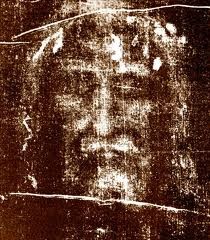
17.02.02.G. THE SHROUD OF TURIN WITH ITS IMAGE OF JESUS. Many believe the image of a man’s face on the Shroud of Turin is the image of Christ that was transferred when His body was placed in the tomb.
Video Insert >
17.02.02.V4 The Shroud of Turin. Michael Keating, a research and development engineer discusses the amazing discoveries concerning the Shroud of Turin that some say was the burial cloth of Jesus. Introduction by Dr. Bill Heinrich. Click here if Internet connection is available.
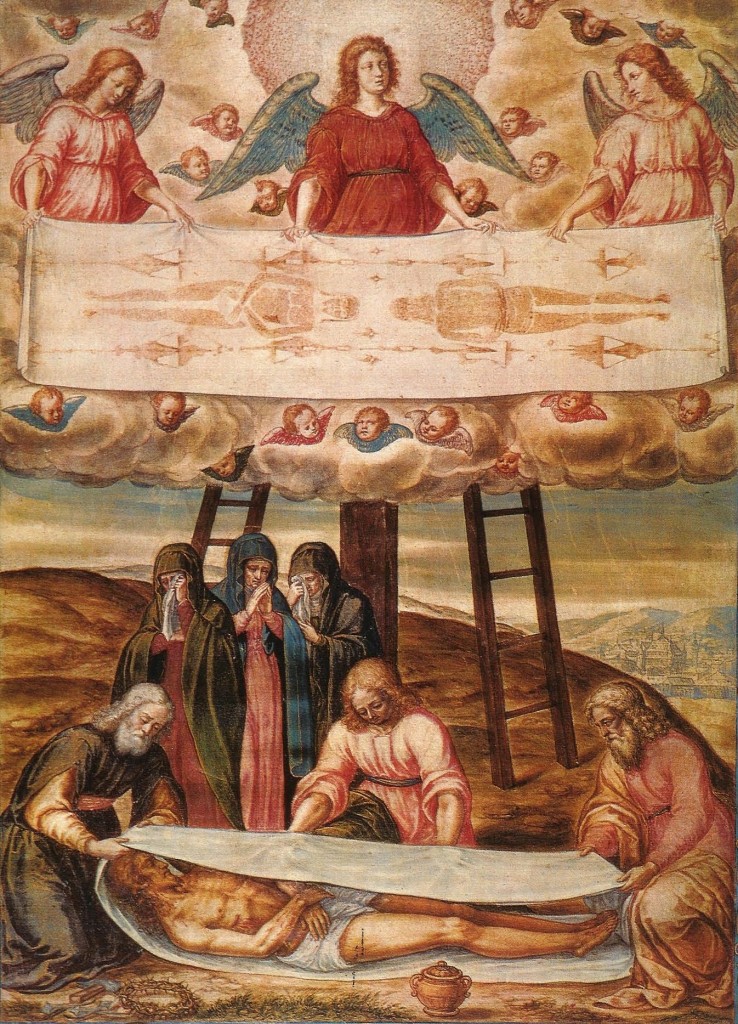
17.02.02.H. THE SHROUD OF TURIN ILLUSTRATED. The Shroud is believed by many to be the prayer shawl that is shown being neatly placed under and over the body of Jesus. The custom was for a man’s prayer shawl to be placed over him in burial. The shrouding (Giulio Clovio, 16th century aquatint composed in honor of the Holy Shroud of Turin), has scenes from the life of Christ set in medallions.
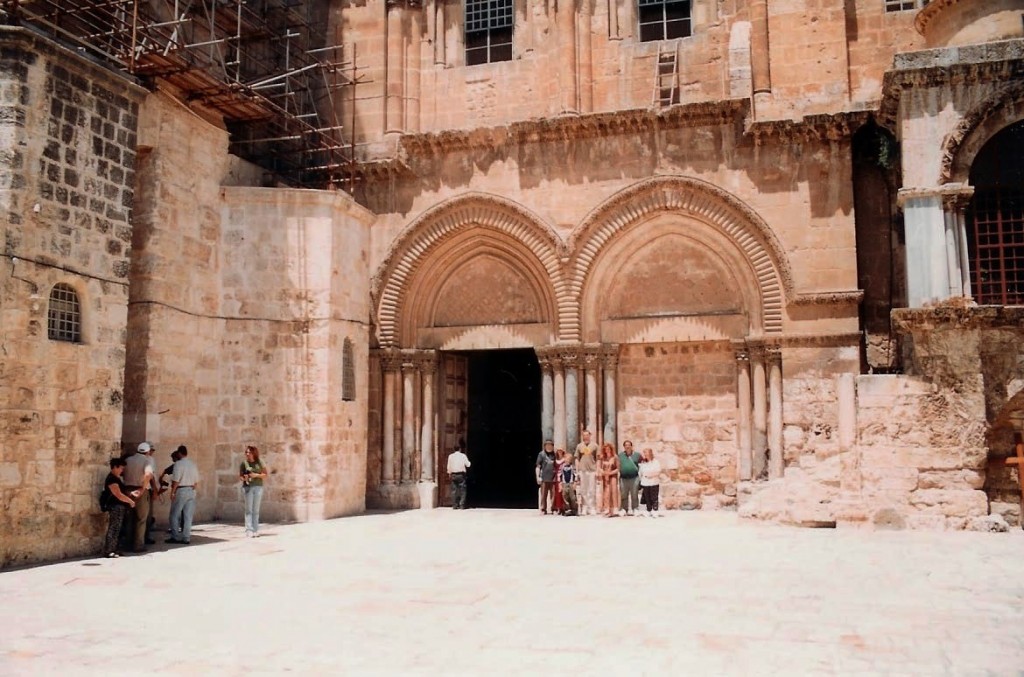
17.02.02.I. CHURCH OF THE HOLY SEPULCHRE. Recent extensive research has determined that the Church of the Holy Sepulchre is, in fact, the actual site of both the crucifixion and burial.[65] Photograph by the author.
[1]. See New International Version Study Bible footnote on John 19:39.
[2]. Mishnah, Shabbath 23.5.
[3]. Babylonian Talmud, Seder Zera’im Berakoth 53a.
[4]. The law of unrelated identities includes principles of kosher foods, not being unequally yoked, not mixing different materials to make fabrics, etc. See Fruchtenbaum, The Jewish Foundation of the Life of Messiah: Instructor’s Manual. Class 26, page 14.
[5]. Crossan and Reed, Excavating Jesus. 237-39.
[6]. Martin, Ernest L. Secrets of Golgotha: The Forgotten History of Christ’s Crucifixion. Associates for Scriptural Knowledge: Alhambra, CA. 1988. See also Ritmeyer, “A Response to Dr. Ernest Martin.” 117-121.
[7]. The red heifer was a necessary component for the purification of a person who came in contact with a dead body. There was a special ritual entailing the sprinkling of its ashes. See Parry, The Complete Idiot’s Guide to the Talmud. 115.
[8]. See a book review by W. H. C. Frend (1989) of Ernest L. Martin’s “Secrets of Golgotha. The Forgotten History of Christ’s Crucifixion.” The Journal of Ecclesiastical History. 40, 449-449.
[9]. Mishnah, Middoth 1:3; 2:4; Mishnah, Yoma 7:2; Babylonian Talmud, Yoma 68a; Babylonian Talmud, Zebhim 105b.
[10]. Lightfoot, A Commentary on the New Testament from the Talmud and Hebraica. 1:83-84.
[11]. Inserts by Danby, ed., Mishnah.
[12]. The whole matter involving the red heifer sacrifice is one this writer believes is in need of further study. See Appendices 6, 26, and 33.
[13]. A summary of Secrets of Golgotha can be found at, Ernest L. Martin, “The Crucifixion Site of Jesus.” Archaeology and Biblical Research 5:4 (Autumn, 1992). 113-121.
[14]. Kloner and Zissu. The Necropolis of Jerusalem in the Second Temple Period. 22-23.
[15]. See also Zondervan’s New International Version Archaeological Study Bible. (2005, ed.). 1615.
[16]. Alden, “Golgotha.” 2:772; Wilkinson, Jerusalem as Jesus Knew It. 146.
[17]. Murphy-O’Connor, “The Garden Tomb.” 12.
[18]. Biddle, The Tomb of Christ. 56-58.
[19]. Map courtesy of Dan Bahat. Illustrated Atlas of Jerusalem. 35.
[20]. Map courtesy of Dan Bahat. Illustrated Atlas of Jerusalem. 59.
[21]. Bahat, Illustrated Atlas of Jerusalem. 35.
[22]. Bahat, “Does the Holy Sepulcher.” 37.
[23]. Shanks, Jerusalem, An Archaeological Biography. 241.
[24]. See Kloner and Zissu. The Necropolis of Jerusalem in the Second Temple Period. Note: Amos Kloner is considered by scholars to have completed the most comprehensive study of hundreds of tombs (First and Second Temple Periods) in the Jerusalem area.
[25]. In a similar manner, centuries later the Muslims build the Dome of the Rock over the temple site and converted St. Mary’s Church, located on the Temple Mount, into a mosque. They never touched Gordon’s Garden Tomb.
[26]. Fischer, The Gospels in Their Jewish Context. (Lecture on CD/MP3). Week 4, Session 1.
[27]. Nelesen, Yeshua; the Promise, the Land, the Messiah. (Video Tape 2).
[28]. Price, The Stones Cry Out. 313.
[29]. Kloner, “Did a Rolling Stone Close Jesus’ Tomb?” 29.
[30]. Kloner, “Did a Rolling Stone Close Jesus’ Tomb?” 28. Kloner also indicates that the Hebrew word for both round (or rolling) and square blocking stones is golal or golel (plural: golalim). See also Kloner and Zissu. The Necropolis of Jerusalem in the Second Temple Period. 54-56. Note: Amos Kloner is considered by scholars to have completed the most comprehensive study of tombs in the Jerusalem area.
[31]. For an exhaustive study on burial practices and tombs during the era of Jesus, see Rachel Hachlili, Jewish Funerary Customs, Practices and Rites in the Second Temple Period. Boston: Brill, 2005.
[32]. Mishnah, Baba Bathra 6.8.
[33]. Kloner and Zissu. The Necropolis of Jerusalem in the Second Temple Period. 77.
[34]. Kloner and Zissu, The Necropolis of Jerusalem in the Second Temple Period. 85.
[35]. For an exhaustive study on burial practices and tombs during the era of Jesus, see Rachel Hachlili, Jewish Funerary Customs, Practices and Rites in the Second Temple Period. Boston: Brill, 2005.
[36]. Kloner and Zissu, The Necropolis of Jerusalem in the Second Temple Period. 688.
[37]. Illustration modified from Bahat, Illustrated Atlas of Jerusalem. 57.
[38]. Bahat, “Does the Holy Sepulcher.” 32.
[39]. Price, The Stones Cry Out. 314.
[40]. Maier, The First Easter. 84.
[41]. Crossan and Reed, Excavating Jesus. 248-49.
[42]. Biddle, The Tomb of Christ. 56-57; Mackowski, Jerusalem City of Jesus. 5; Wilkinson, Egeria’s Travel’s. 146-47 quoting Egeria’s Travels.
[43]. See “Madaba Map” in Appendix 26; See also 14.02.03.D and 05.02.03.Z.
[44]. Parenthesis mine.
[45]. Thiede and d’Ancona. The Quest for the True Cross. 62.
[46]. Pixner, “Church of the Apostles Found.” 24, 60 n20.
[47]. Wiseman and Yamauchi, Archaeology and the Bible. 84-86.
[48]. McDowell, “The Historical Reliability of the New Testament.” 48.
[49]. Bahat, “Does the Holy Sepulcher.” 33.
[50]. Bahat, “Does the Holy Sepulcher.” 34-35.
[51]. Shanks, “After Hadrian’s Banishment: Jews in Christian Jerusalem.” 33.
[52]. For further study, see two articles by John Long: “The Shroud’s Earlier History. Part 1: To Edessa.” Bible and Spade. 20:2 (Spring, 2007). 46-52 and “The Shroud’s Earlier History. Part 2: To the Great City.” Bible and Spade. 20:4 (Fall, 2007). 120-128.
[53]. The Code of Jewish Law, a/k/a the Shulchan Aruch, is the Jewish code of law written by Rabbi Yosef Kara about 500 years ago. It summarizes and lists the halachic decisions of the Talmud as well as the author’s own view based on halachic opinions and discussions of the commentaries after the Talmud. Topics discussed are divided into chapters. It is mentioned here because it refers to second temple period traditions, but it is not quoted as it is not an ancient source. See Code of Jewish Law, “Laws of Mourning.” Chapters 351-354, 362-64; http://www.shulchanarach.com/
[54]. This sentence that pertains to a broken roof rafter is a comparative statement. It suggests that just as a bench or the side piece of a bed is used to prevent a rafter from bending or breaking any further, so too, the chin of a corpse is tied to keep the jaw from “sinking,” or opening, any further.
[55]. Bracketed inserts by Danby, ed.
[56]. Wild, “The Shroud of Turin: Probably the Work of a 14th Century Artist or Forger.” 31-32.
[57]. Hands and feet were nailed to the cross: Lk. 24:40; Jn. 20:20,25,27; Col. 2:14; Scourging wounds: Mt. 27:26; Mk. 15:15; Lk. 23:16, 22; Jn. 19:1; Thorn impressions on the head Mt. 27:29; Mk. 15:17; Jn. 19:2; Bruise marks to the shoulders (from carrying the cross?) Jn. 19:17; Bruise and blow marks to the face Mt. 26:28; 27:30; Mk. 14:65; 15:19; Lk. 22:63-64; Jn. 18:22; 19:3.
[58]. Nelesen, Yeshua; the Promise, the Land, the Messiah. (Video Tape 2).
[59]. Habermas, “The Shroud of Turin and its Significance for Biblical Studies.” 51.
[60]. McCrone, “The Shroud Painting Explained.” 29.
[61]. McCrone, “The Shroud Painting Explained.” 29-30.
[62]. Vikan, “Debunking the Shroud.” 28.
[63]. For more information, see Vaughn M. Bryant Jr. “Does Pollen Prove the Shroud Authentic?” Biblical Archaeology Review 26:6 (Nov/Dec, 2009). 36-44. See also Alan D. Whanger, Uri Baruch, and Mary Whanger. Flora of the Shroud of Turin. St. Louis, MO: Missouri Botanical Garden Press, 1999.
[64]. See also Long, “Closing in on the Shroud’s Early History. 20-22.
[65]. Biddle, The Tomb of Christ. 56-58; Mackowski, Jerusalem City of Jesus. 5.
17.02.03 Mt. 27:62-66 Thursday night or early Friday morning.
SOLDIERS GUARD TOMB
62 The next day, which followed the preparation day, the chief priests and the Pharisees gathered before Pilate 63 and said, “Sir, we remember that while this deceiver was still alive He said, ‘After three days I will rise again.’ 64 Therefore give orders that the tomb be made secure until the third day. Otherwise, His disciples may come, steal Him, and tell the people, ‘He has been raised from the dead.’ Then the last deception will be worse than the first.”
65 “You have a guard of soldiers,” Pilate told them. “Go and make it as secure as you know how.” 66 Then they went and made the tomb secure by sealing the stone and setting the guard.
“The chief priests and the Pharisees.” While the Sadducees were before Pilate demanding the death of Jesus, the leading Pharisees disappeared and were not involved in the demand of His death. They believed they would be innocent of His death if they would not be actively involved in the eviction and execution. However, now that Jesus was dead, they emerged and joined the Sadducees (chief priests) before Pilate with a concern that He might rise on the third day.
“Deceiver.” In the Jewish tradition, whenever someone was scorned, his name would not be repeated. Rather, degrading words were used to refer to Him and, in this case, the Sadducees used the term “deceiver” to refer to Jesus. It was and continues to be the cultural way to blot out His name forever.
The gospel writers said that the Jewish leaders accused Jesus of leading the people astray (Jn. 7:12, 47), that He used the power of Beelzebul (Mk. 3:22), and that He had a demon (Jn. 10:19-21). Centuries later, when the Babylonian Talmud was written, the same accusations continued. The Jews never question whether He performed miracles, only the source of His power to do them. In Sanhedrin 43a, the Jewish writer first created a historical account to “prove” a legitimate court trial, which is followed by the reason of the trial – the accusation of sorcery and apostasy.
It was taught: On the eve of the Passover, Yeshu [ms. M: the Nazarene] was hanged. For forty days before the execution took place, a herald went forth and cried, “He is going forth to be stoned because he has practiced sorcery and enticed Israel to apostasy. Anyone who can say anything in his favor, let him come forward and plead on his behalf.”
Babylonian Talmud, Sanhedrin 43a
In the following account, the Talmudic writer not only describes Jesus as an idol worshipper, (i.e. the brick) but then also accuses Him of magic – an admission that Jesus had incredible powers.
One day he [Rabbi Joshua] was reciting the Shema when Jesus came before him. He intended to receive him and made a sign to him. He [Jesus] thinking it was to repel him, put up a brick and worshipped it.
“Repent,” said he [rabbi Joshua] to him. He replied, “I have thus learned from you: He who sins and causes others to sin is not afforded the means of repentance.” And a Master [another major rabbi] has said, Jesus the Nazarene practiced magic and led Israel astray.”
Babylonian Talmud, Sanhedrin 107b[1]
On an interesting side note: the irony is that in today’s post-modern world, there are a number of critics who claim that Jesus never existed. If there is any group of people who wished that were true, it is the Jews who have been struggling against Jesus for two thousand years. Their admission that Jesus existed flies in the face of modern critics.
“Three days.” For an explanation on the term “three days and three nights,” see 09.01.05.Q2.
“Made the tomb secure by sealing the stone and setting the guard.” A stone was always rolled in front of the tomb to keep dogs and other animals from desecrating the body. However, in this case a seal was placed on the stone to keep the disciples out. To place a seal, the guards placed a rope, known as a golal, across the front of the stone.[2] At the ends, they placed a wax seal with a Roman impression. If the seal was broken, the culprit and the guards were executed.[3] Obviously, they were faithful to their superior commander, especially in the case of guarding the tomb of a popular dead Jew. This explains the extraordinary measures taken by the Pharisees and Roman officials to insure that Jesus would not rise from the tomb.[4] Yet history records that the resurrected Jesus became a matter of great concern, even for the Romans.
In 1878 an ordinance issued by Emperor Claudius was discovered in Nazareth and brought to Paris. The “decree of Caesar,” written in Koine (common) Greek, was inscribed on a 15 by 24 inch marble tablet in A.D. 50. It sets forth a most unusual proclamation, in that those who violate a grave would receive capital punishment.[5] However, the discovery was not made public until 1925, when there was public and academic response to it. Its authenticity has rarely been questioned and its similarity to Matthew 28:11-15 is stunning. The significance of the ordinance is that it would be highly improbable that the body of Jesus was stolen by His disciples.[6]
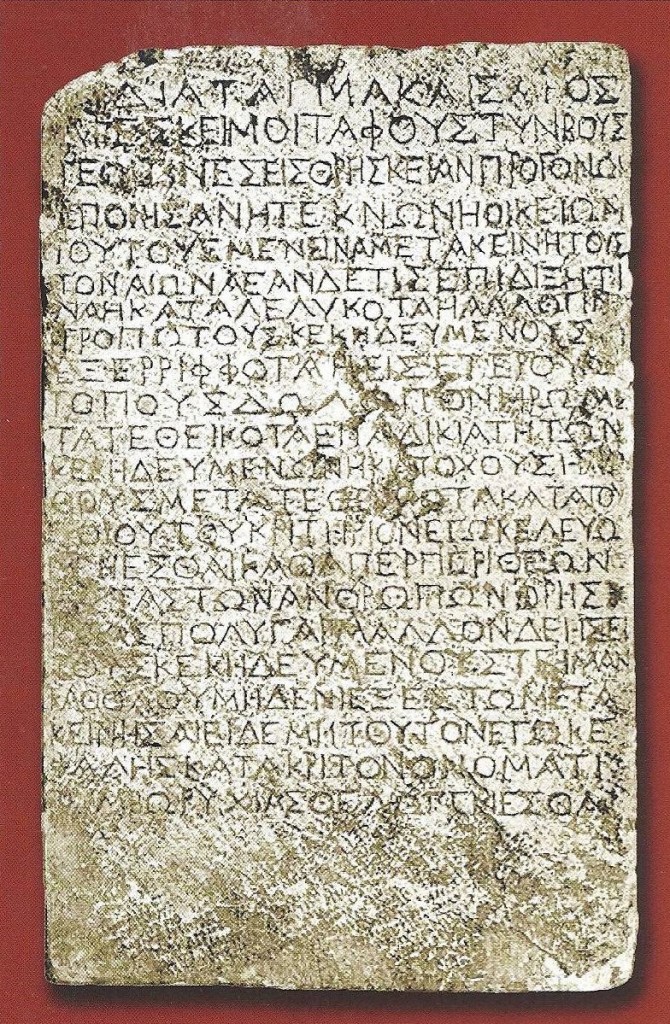
17.02.03.A. THE NAZARETH INSCRIPTION, also known as the ORDINANCE OF CAESAR. The Imperial inscription, bearing the title Diatagma Kaisaros found near Nazareth is dated to A.D. 50. Amazingly, the marble stone declares that it is illegal to steal a body from a tomb. The Jewish leaders were highly angered at the spread of the new faith in Jesus as the Messiah. It is strongly believed this ordinance was enacted to squelch the rumors of a resurrected Christ.
The decree reads as follows:
Edict (Ordinance) of Caesar[7]
Amazingly, to pronounce a death sentence upon someone who “violated” a tomb was an extremely harsh sentence, even in Roman days. This edict is a testimony that news of the life, death, and resurrection of Jesus had spread throughout the Roman Empire, even to the highest levels of Rome itself, within two decades. The inscription is one of the most powerful pieces of extra-biblical evidence that the resurrection of Jesus was taught and influential in the first century, the beginning of Christianity.[8] Furthermore, the lives and martyrdoms of the apostles is clear evidence of a risen Christ.[9]
17.02.03.Q1 What significant extra-biblical comments on the life and death of Jesus survived the centuries?
One of the most notable was Flavius Josephus. He gave this brief observation concerning Jesus:
Now, there was about this time Jesus, a wise man, if it be lawful to call him a man, for he was a doer of wonderful works – a teacher of such men as receive the truth with pleasure. He drew over to him both many of the Jews, and many of the Gentiles. He was [the] Christ; and when Pilate, at the suggestion of the principal men amongst us, had condemned him to the cross, those that loved him at the first did not forsake him, for he appeared to them alive again the third day, as the divine prophets had foretold these and ten thousand other wonderful things concerning him; and the tribe of Christians, so named from him, are not extinct at this day.
Josephus, Antiquities 18.3.3 (63-64)
Critics have said that this paragraph is not original, but claim it is a Christian interpolation of a later edition. They stated a loyal Jew would not have made such a statement. However, two significant church fathers, Jerome and Ambrosius[10] accepted it as original. Eusebius not only quoted Josephus, but then said the following,
When such testimony as this was transmitted to us by an historian who sprung from the Hebrews themselves, both respecting John the Baptist and our Savior, what subterfuge can be left to prevent those from being convicted destitute of all shame, who have forged the acts against them? This, however, may suffice on this subject.
Eusebius, Church History 1.11.9
Those scholars who considered it an original work point to an early Arabic translation, because it included the same comment.[11] On the other hand, the Jewish account of the death of Jesus in the Babylonian Talmud is one of the travesties of historical records. Jewish historians are known for their accuracy and reliability, but in dealing with Jesus, their credibility fails miserably. This reflects how problematic Jesus was and continued to be for them. In the fourth century, the following account was prepared to give some resemblance of correct legal procedure in the trial and execution of Jesus. There is no mention of the house of Annas that is elsewhere described with contempt, nor is there any mention of the Romans, who performed the execution. Consequently, the Jews justified His death based on Deuteronomy 13.
On the eve of the Passover, they hanged Yeshu (Jesus). For forty days before the execution took place, a herald went forth and cried: Yeshu of Nazareth is going forth to be stoned, in that he practiced sorcery and led Israel astray. Let anyone knowing anything in his defense come and plead for him. But they found nothing in his defense, and hanged him on the eve of the Passover.
Babylonian Talmud, Sanhedrin 43a
In the same section of the Babylonian Talmud is this comment.
Rabbi Ulla said, “Would you believe that any defense would have been so zealously sought for him? He was a deceiver, and the All-merciful says: ‘You shall not spare him, neither shall you conceal him.’ It was different with Jesus for he was near to the kingship.”
Babylonian Talmud, Sanhedrin 43a
Those who were against Jesus before the crucifixion were also against Him afterwards. As previously stated, they accused Him of being a magician, a deceiver, and an artist of magic art. In the second century, before the Babylonian Talmud was written, Justin Martyr made a statement that affirms the accusations of the later Talmud authors. Martyr said,
They said it was a display of magic art, for they even dared to say that he was a magician and a deceiver of the people.
Justin Martyr, Dialogue with Trypho 97:7[12]
Jesus was not the only one privileged to be accused of doing magical works of demons. The Roman satirist Juvenal, in the century after Jesus, said that everywhere throughout the Roman Empire, Jewish magicians, dream expounders, and fortune tellers were found.[13] Evidently, His disciples were given the same honors by disgruntled Jews, as recorded by Origen in the second century. Their concern was not that the miracles were performed, but their debate was focused on His source of power:
Since these men do these wonders, ought we to think them sons of God? Or ought we to say that they are the practices of wicked men possessed by an evil demon?
Origen, Against Celsus 1:68
Amazingly, while the Pharisees accused Jesus of performing exorcisms by using demonic powers, they also believed that the ability to perform exorcisms was a gift of God – a direct violation of their accusations against Jesus. The accusations that began during the life of Christ continued for centuries.
The phrase “near to the kingship,” in the Babylonian Talmud’s Sanhedrin 43a is a reference to the messianic prophecy that the Messiah would be a descendant of King David,[14] which makes this a rather interesting comment. A third comment about Jesus in the same section of the Talmud is this:
The rabbis taught: “Jesus had five disciples: Matthias, Naquin, Never, Buna, and Torah.”
Babylonian Talmud, Sanhedrin 43a
Obviously, this passage is of no historical value other than it adds insight to how negatively Jesus was seen by Jewish leaders centuries later. This rabbinic writing does, however, give evidence for the life of Jesus, which they so desperately tried to destroy. The commentary of Sanhedrin 43a reveals the following,
Possibly the most interesting aspect is that this paragraph makes no mention of Roman trials or execution. It does, however, explain that Jesus was put to death by the Jews themselves. This is clearly a confession that national Israel was responsible for the death of Jesus, an awesome statement from a non-biblical text.
The life of Jesus was also confirmed by pagans, although in a negative manner. The fact that pagan authors were uncharacteristically strong in their comments suggests the influence Jesus had. As dynamic as Jesus was throughout His life, the concept that He permitted Himself to be crucified and the idea that He could be God was beyond comprehension for many. For many Jews it was a difficult challenge to accept, given their preconceived ideas of who the Messiah would be. Yet for the Greeks and Romans the idea was even more difficult to accept. Christians soon became persecuted targets throughout the Roman Empire. While many accepted Jesus as Lord and Savior, others despised Him and said that Jews and Christians worshiped a god in the form of a donkey. The donkey, being rather docile and low in intelligence, became a symbol of Jews and Christians for those who hated them and were quick to spit out their vulgar blasphemies.
While the New Testament writers recorded antagonism between Jews and the apostles, the Jewish-inspired violence appears to have dissipated by the second century. Jewish writings, nevertheless, defended the accusatory positions of the leading rabbis, as is found in two accounts of the Babylonian Talmud.
One day he [Rabbi Joshua] was reciting the Shema when Jesus came before him. He intended to receive him and made a sign to him. He [Jesus] thinking it was to repel him, put up a brick and worshipped it.
“Repent,” said he [rabbi Joshua] to him. He replied, “I have thus learned from you: He who sins and causes others to sin is not afforded the means of repentance.” And a Master [another major rabbi] has said, Jesus the Nazarene practiced magic and led Israel astray.”
Babylonian Talmud, Sanhedrin 107b[15]
It was taught: On the eve of the Passover, Yeshu [ms. M: the Nazarene] was hanged. For forty days before the execution took place, a herald went forth and cried, “He is going forth to be stoned because he has practiced sorcery and enticed Israel to apostasy. Anyone who can say anything in his favor, let him come forward and plead on his behalf.”
Babylonian Talmud, Sanhedrin 43a
Obviously, there are numerous conflicts with the passage above and the biblical account. But the question the rabbis and other critics cannot answer is, if Jesus did worship a brick, if he practiced sorcery, if he was a fraud, then why were all of his disciples willing to die a martyr’s death? They must respond to the concept that Jesus was either a liar, a lunatic, or the Son of God. If a dozen men, living with Him every day for more than three years determined that He was neither a liar nor a lunatic, there is then only one other option. If Jesus was the Son of God, then did He fulfill the Old Testament requirements and prophecies? Did He perform miracles? Did hundreds of people speak to Him after His death and resurrection?[16] If so, then, obviously, He was/is the Son of God.
Rabbinic literature says little of Jesus, and when it does, the commentary is negative. A notable exception is a comment in the Babylonian Talmud (Gittin 56b-57a) that is dated to the early second century. It implies a degree of harmony between the traditional Jewish people and Nazarene believers. While a number of false doctrines of prevalent heresies are mentioned, there is no specific accusation against Christianized Jewish people or a denial of the miracles performed by Jesus.
However, the Gittin comment is the exception rather than the rule. It is interesting that the Jews never denied that He performed miracles, but they attributed His power to demonic sources. Hence, rabbinic literature describes Jesus as One who led souls into apostasy and accused Him of being a sorcerer (cf. Mt. 12:24).[17] While negative in nature, there was no doubt among Jews that Jesus performed miracles.
In the meantime, the disciples and thousands of followers of Jesus had their world shattered at the unexpected crucifixion. How could anyone who performed so many incredible miracles allow Himself to be crucified? And why? Their depression and sadness must have been as dark as the sky in the afternoon of Passover. But that was about to change.
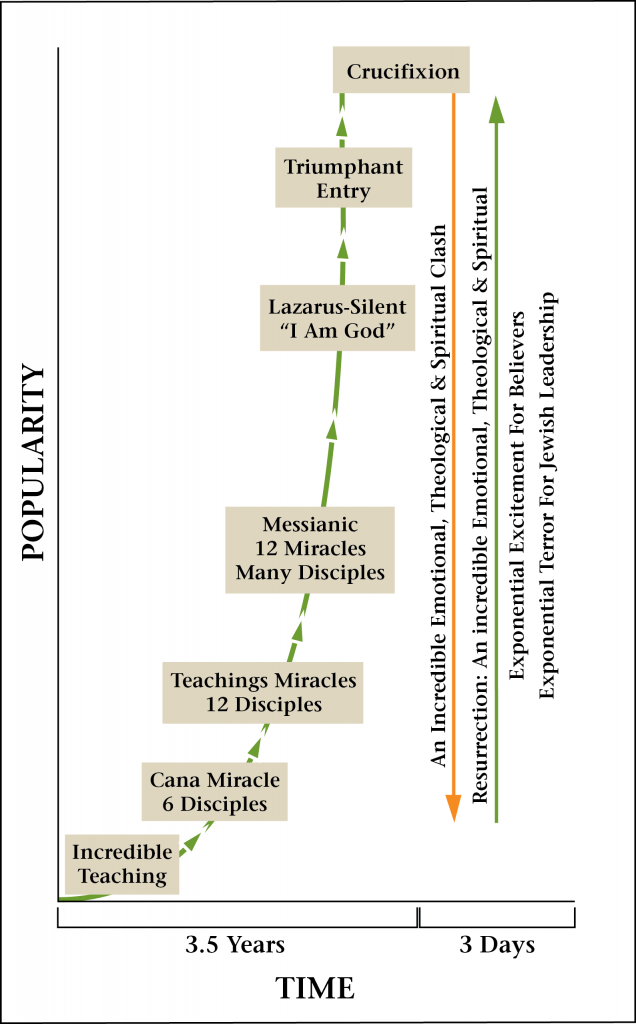
17.02.03.B THE POPULARITY – TIME CHART OF THE MINISTRY OF JESUS. The ministry of Jesus grew slowly at first, but quickly gained popularity and then to exponential growth. The enormous excitement was crushed by His crucifixion, but that emotional crash was replaced with the explosive excitement of His resurrection. Courtesy of International Mapping and Dan Przywara.
[1]. See also Babylonian Talmud, Sotah 47a and Jerusalem Talmud, Hagiga 2.2.
[2]. Because the stone was “rolled,” it has always been assumed that it was round. However, archaeologists have uncovered only four round disc-shaped tomb blocking stones, but more than a hundred square ones which were also rolled due to their size and weight. See Kloner, “Did a Rolling Stone Close Jesus’ Tomb?” 28.
[3]. Farrar, Life of Christ. 454-55; Fruchtenbaum, The Jewish Foundation of the Life of Messiah: Instructor’s Manual. Class 25, page 20.
[4]. Farrar, Life of Christ. 457.
[5]. Avi-Yonah and Kraeling, Our Living Bible. 299-300.
[6]. Smith, “Nazareth Decree.” 3:501.
[7]. Translation by Clyde E. Billington; Billington, “The Nazareth Inscription.” 17; Tenney, ed., “Nazareth Decree.” 11:1355.
[8]. Compton. “Is the Resurrection Historically Reliable?” 106; Billington. “The Nazareth Inscription: Proof of the Resurrection of Christ?” 17.
[9]. See Appendix 27 concerning the lives of the apostles.
[10]. St. Jerome (c. 347-420) was the son of church father and historian Eusebius and Ambrosius (c. 340-397), a/k/a St. Ambrose (Aurelianus Ambrosius) was the bishop of Milan.
[11]. Santala, The Messiah in the New Testament. 28-29.
[12]. See also First Apology 30 and Dialogue with Trypho, the Jew 108.
[13]. Juvenal, Satire 6:543-548. See http://archive.org/stream/juvenalpersiuswi00juveuoft/juvenalpersiuswi00juveuoft_djvu.txt. Retrieved June 11, 2014.
[14]. House, Chronological and Background Charts of the New Testament. 77.
[15]. See also Babylonian Talmud, Sotah 47a and Jerusalem Talmud, Hagiga 2.2.
[16]. For further study on the significance of the physical resurrection of Jesus, see Geisler, Norman L. “The Significance of Christ’s Physical Resurrection.” Bibliotheca Sacra. 146:582 (Apr-June, 1989) 148-70.
[17]. Fluesser, “The Jewish-Christian Schism” (Part II). 30-31.